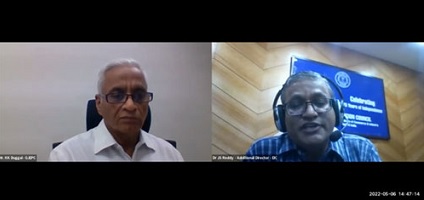The Council had organized a webinar to discuss the key aspects and procedures of the agreement

The Gems & Jewellery Export Promotion Council (GJEPC) had organized a webinar titled ‘Understanding the certificate of origin procedure for exports in the India -UAE CEPA Agreement’ on May 6. The objective of the webinar was to discuss the key aspects and procedures of the agreement with special emphasis on the certificate of origin procedure for exports. Speakers included Dr J S Reddy, Additional Director, Export Inspection Council, New Delhi and Kuldeep Singh, Deputy Director, Export Inspection Agency, New Delhi. The session was attended by around 200 participants and concluded after addressing their queries by the panelists with a vote of thanks by KK Duggal, Director, Policy.
India and UAE have signed a Comprehensive Economic Partnership Agreement on February 18, with an aim to boost the merchandise trade between the two countries to US$ 100 billion over the next five years. The agreement has come into force on May 1, 2022 and is expected to generate a wide variety of benefits for Indian exporters in terms of free-market access for gems and jewellery products and other products in UAE market and procurement of raw materials at competitive prices in India.
However, in order to avail this concession exporters must produce a ‘Certificate of origin’ that shows that the jewellery exported is of Indian origin. A Certificate of Origin, is an important international trade document that certifies that goods in a particular export shipment are wholly obtained, produced, manufactured, or processed in a particular country. They declare the ‘nationality’ of the product and serve as a declaration by the exporter to satisfy customs or trade requirements. The rules of origin are enforced through this certificate that is issued by authorised agencies of the trading partner. An exporter cannot avail the customs tariff preferences under the FTA without submitting the certificate of origin from the authorised agency. This webinar was conducted to guide exporters on how to obtain a Certificate of Origin. K K Duggal said that under this arrangement, Indian jewellery can be exported to UAE and get a duty concession of 5% which otherwise is levied on Indian jewellery. “To take benefit of this 5% exemption goods should be accompanied by a Certificate of Origin certifying that this is Indian jewellery. This certificate is to be given by a government agency. For our sector DGFT and the regional office of DGFT along with export inspection agencies under the Export Inspection Council are authorized to give these certificates.”
Duggal added, “On the very first day when this agreement became operational, our sector was one of the first sectors to arrange 3 shipments which went to Dubai with a Certificate of Origin issued by the export inspection agency in May. So that was a very big achievement and historic day for our sector, and we are grateful to Dr. Reddy and Mr. Kuldeep who helped the exporters to fill the forms and obtain the Certificate of Origin.” Dr. J S Reddy said, “With this initiative, exporters sitting anywhere can apply online and understand the documents and requirements needed while registering. The certificate of origin is like a promissory note of financial nature. The certificate of origin is not the final step while availing benefits and the customs authorities can use the certificate as a reference document and ask for additional documents to verify the rules of origin.”
Be the first to comment